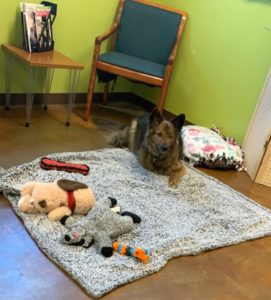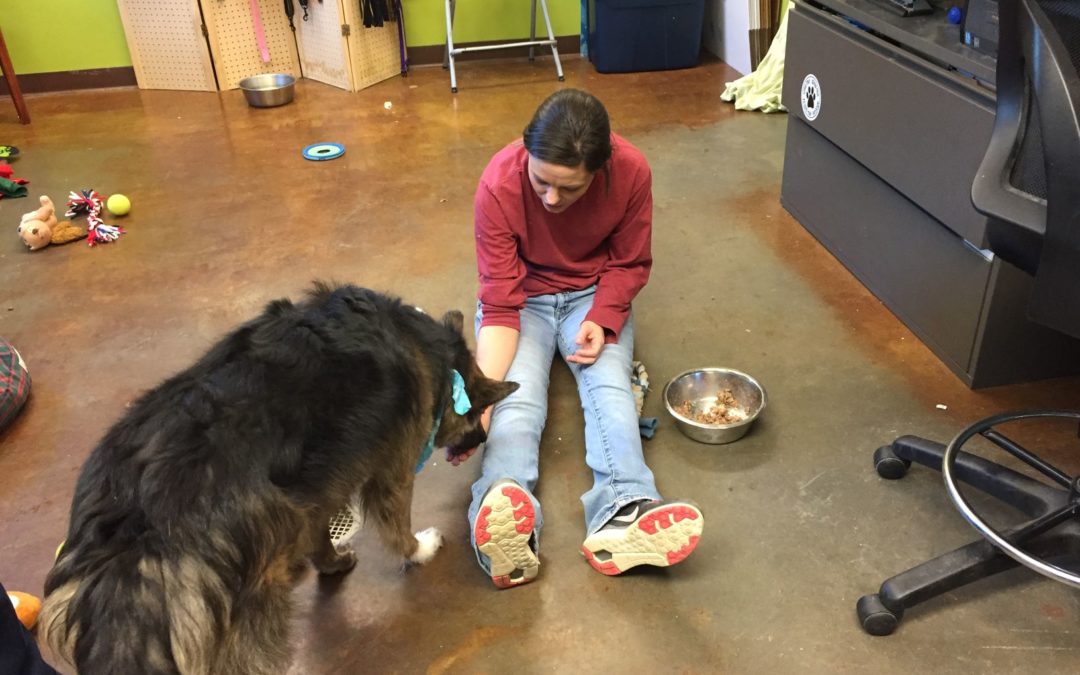We know that many of you have been following the dog Carter’s story on Facebook. With heavy hearts, we reach out now to share that we made the heartbreaking decision to humanely euthanize Carter due to his complicated medical condition and behavior history. This was done yesterday, with staff and board members present to offer him love and peace during this last journey.
As many of you are aware, Carter was recently returned to our care due to some behavioral issues, including snapping, lunging, and biting. When he returned to us, we noted a limp and sent him to our vet for evaluation. Multiple sets of x-rays revealed that Carter had an old pelvic fracture that resulted in painful hip degeneration. During his recent time with us, he was also extremely stressed and anxious and displayed aggressive behaviors, such as unpredictable lunging and attempts at biting. 
While we continued to monitor Carter’s behavior, multiple veterinary experts advised that Carter was not a candidate for hip replacement. Other treatment options would have involved more pain, and therefore more distress for Carter. Additionally, based on our professional knowledge and vet consultations, we did not not believe surgery would change the dangerous behavioral response Carter had to new situations. Because of his unpredictable behavior, we would have been placing a foster caregiver or adopter at considerable risk.
With these considerations in mind, and in consult with our veterinary team, we determined that euthanasia was the most humane option for Carter. This was a painful decision for all of us at Paws4ever. We are grieving, and we know others in our community are too. This decision has been incredibly hard. As with all euthanasia decisions, it has taken a toll on our staff and volunteers. However, as Carter’s caregivers, we feel strongly that we had a responsibility to make this decision – for Carter and for our community.
At Paws4ever, we commit to our animals for a lifetime. Euthanasia is a last resort and we never euthanize due to space constraints. When making this decision we follow guidelines that weigh medical and behavioral factors, our ability to care for the animal, the animal’s quality of life, and the safety of our animals, staff, volunteers and community. When considering behavioral euthanasia in particular, we must proceed with an extremely high level of caution and recognize that we have an ethical responsibility to be conscious stewards of community safety and well-being.
In Carter’s case, our decision took into consideration his medical diagnosis, history of concerning behavior and anxiety related to his medical condition and treatment. Based upon our professional experience, we also recognized that his behavior most likely would worsen during treatment and not improve afterwards.
We know this situation is not only difficult for our team but also for our community. We know that you all love animals just as we do – and that we are all working towards the same vision of a world where pets and people thrive together. We appreciate all of you who stand up for the interests of animals, and we respect your passion and commitment. We are all in this together to save more animals. We appreciate the outpouring of support that we have received from many of you, and we thank you for being understanding and compassionate as we all grieve.
In order to provide additional information, we have answered some of the questions we’ve been asked frequently about this decision.
Does euthanizing Carter mean that Paws4ever isn’t a no-kill shelter?
Paws4ever never euthanizes for space or simply because an animal doesn’t yet have an adopter. However, all reputable animal rescues have ethical and responsible euthanasia policies which include euthanasia as a compassionate end-of-life decision when an animal is suffering from a severe medical or behavioral condition, or when an animal poses a risk to the safety of the community.
Did Carter always seem aggressive?
Animals who show aggression don’t necessarily display that aggression all of the time. We evaluate animals with a history of aggressive behavior using a number of criteria, including the type and severity of the aggressive incidents, and the predictability of the animal’s behavior, in order to determine the potential risk the animal poses to children, adults, and animals in the community. We make initial behavior assessments when we rescue an animal, but we do not always have access to comprehensive background information on pets surrendered to county shelters. We continually assess animal behavior as new information becomes available and as observations are made.
Why didn’t you notice Carter’s pain earlier?
Dogs don’t always show pain in the same ways that people do, and they can’t explain to us how they feel. Especially when a condition has been long-term, dogs try to adapt to their condition and don’t always display visible signs of being hurt or sick. When we rescue an animal that has been surrendered to a county shelter, we do not always have access to comprehensive background information on them. Carter was adopted shortly after we rescued him, and it was not until he was returned to us that we saw him limping. However, we have since learned that both his pain from the pelvis injury and his displays of aggression have likely been long-term.
Did Paws4ever do everything possible for Carter?
The decision to humanely euthanize an animal is never taken lightly. We are committed to providing quality care for all of our animals. When we noted Carter’s limp, we immediately took him to the vet for evaluation and x-rays. We have been working with multiple veterinary professionals over the past several weeks to determine the most humane course of action for Carter, taking into consideration both the medical and behavioral factors. In this case, it was determined that Carter was not a good candidate for surgery, and that his aggression posed a considerable safety risk. Our decision to euthanize was made out of compassion for Carter and responsibility to the community.
Could training have fixed his behavioral problems?
Paws4ever has a team of professional dog trainers who work with our animals and form custom training and behavior support plans for many of our dogs. Staff and volunteers work with our adoptable dogs to prepare them to be happy and polite members of their future families. While many behavioral concerns can be addressed through training, our observations and veterinary consultations led us to determine that in this particular case, Carter’s behavior was both a safety risk to the community and unlikely to improve.
Why wasn’t Carter available for adoption or transferred to another rescue?
As conscious stewards of community safety, we cannot ethically place an animal in a home if we have determined him to be a safety risk, and we cannot pass along that risk to another organization.
Additionally, knowing that he would not be adoptable, transferring him to another rescue would have prolonged the amount of time he had to be anxious and stressed before that organization would have had to make the decision to humanely euthanize him. When we rescue an animal, it is our responsibility to do what is best for the animal, even when it breaks our hearts.

